RIGHT TURN ONLY!!
Society for the Study of Really Awesome Endings
by Carlo Santos,

I'd like to thank all the readers who follow this column regularly, even if I don't always pick out the best or most interesting manga each time.
I'd especially like to thank the readers who disagree with me and chew me out, because it keeps my already overinflated ego in check.
I'd like to thank the Stateside publishers who continue to make great efforts to bring us this unique and varied art.
I'd like to thank the Japanese publishers and creators, of course, as they continue to evolve in different ways, and I know that somewhere out there, there's always some crazy, determined manga-ka feverishly working on something that's going to be just perfect for me. Because finding a new favorite is the most fun of all.
And that's my RTO Thanksgiving wish. (A few days late, but you get the point.)
FALL IN LOVE LIKE A COMIC

Vol. 1
(by Chitose Yagami, Viz Media, $8.99)
FROM THE BACK COVER:
"Rena Sakura is a high school student with a secret: she's a professional mangaka. And although she's never been on a date, that doesn't stop her from drawing steamy shôjo scenes for Cha♥mi magazine. But when the gorgeous Tomoya Okita finds out her secret, she finds herself asking him out to get some real-life experience in love!
Rena asks Tomoya to be her boyfriend, hoping that gaining some experience in dating will help her improve her manga. Rena is positive that Tomoya is only dating her to help her out, but that doesn't stop her from falling in love..."
EVIDENCE FOR:
Just from the plot summary, you can tell that this is going to get dangerously self-referential, but the tongue-in-cheek attitude and likeable characters keep this love comedy on the light side. Rena makes for an amusing heroine, with her perpetual states of embarrassment, and her super-cute character design lends itself naturally to visual gags: wacky reaction faces, pratfalls, and melting into a puddle of goop. Of course, something must also be said about Tomoya, who fits into the bishounen love-interest role so perfectly that one has to laugh at his over-the-top gallantry and dashing good looks. A couple of plot twists and emotional breakdowns help to keep the story moving—it'd be lame, after all, if the only thing Rena and Tomoya did was get together and go out on dates. Instead, she's fighting jealousy and rivalry on all fronts, and the best part is when it comes from the industry side: beware, budding manga-ka, when your series gets adapted for TV and the writers decide to mess with your precious characters. But with all the sparkles and smiles and shiny eyes, you know that love's going to win out in the end, and that's what makes this fun.
EVIDENCE AGAINST:
For a title and story concept that's so obviously poking fun at itself, the actual manga is surprisingly deficient when it comes to ... well ... poking fun. Instead, it just goes through the motions of the usual high school girl romance, as if to say: "Well, of course we're doing a stereotypical shoujo manga story, because that's what we're poking fun at." Sorry folks, but parody doesn't work that way—now you're just making a carbon copy. Not only that, but it's a carbon copy with all the depth of a Petri dish—apparently, the use of stereotypical characters for comedic effect means that there's no need to develop their emotions or relationships. More than that, even Rena's (highly improbable) manga career is portrayed poorly, as it basically involves a whole lot of drawing, fighting deadlines, and visits to the editor. Maybe I'm just spoiled, but after reading industry insights like Even a Monkey Can Draw Manga, Super Cruel and Terrible Tales of Mangaka, and to an extent even Genshiken and School Rumble, stuff like this falls horribly short. Throw in the usual messy layouts and overuse of tones and it turns out that Fall in Love Like a Comic is also Flawed and Mediocre Like a Comic.
FINAL VERDICT:
It's a cute and bouncy look at the conventions of shoujo romance, but by being A Slave to those conventions, it comes out as a cookie-cutter C.
GAKUEN ALICE
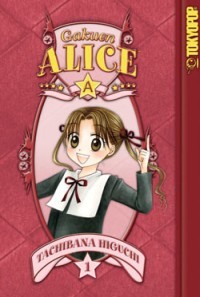
Vol. 1
(by Tachibana Higuchi, Tokyopop, $9.99)
FROM THE BACK COVER:
"Young Mikan runs away to Tokyo following her best friend, Hotaru, who has been enrolled in an exclusive, secretive private school for geniuses. But it turns out that Alice Academy is a lot more than meets the eye. Whether it's Hotaru's gift for inventing gadgets, the cranky Natsume's fire-casting ability, or Professor Narumi's control of human pheromones, everyone at the school has some sort of special talent. But what ability, if any, does Mikan possess? Mikan is going to have to rely on her courage and spunk if she's going to stay in school, or even stay alive!"
EVIDENCE FOR:
With its far-fetched concept, flashes of magic, and grade-school shoujo trappings, Gakuen Alice sure reads like a fairytale—but one of the dark, disturbing Grimm originals, not some sanitized 20th-century version. Beneath the surface lie some surprising scenes of bullying, violence, and general cruelty among children. This is what it's really like to be the new kid at school: nobody trusts you, you've already made enemies with the meanest guy in class, and even your best friend is showing signs of moral ambiguity. Mikan and Hotaru's relationship is shown as a struggle between polar personalities, and the two main boys, Natsume and Luca, have issues about their own talents. Later on, the fairytale part really takes off in the last couple of chapters when Mikan and friends go on a trek through the school forest. Strange and cute animals abound, special powers are revealed, and the troubled feelings that have been building up reach a boiling point at the end of this volume. It's fanciful, but it's certainly not fluff, as this story reaches into some of the deepest fears and worries that we all have as children.
EVIDENCE AGAINST:
Let's see, a secretive school with a tough admissions policy, a generation of children with unusual abilities, a heroine who unleashes her power as she's thrust into danger—honestly, it's hard to tell where the rip-offs end and the actual story begins. If Gakuen Alice is trying to innovate on a formula, well, it's not doing much aside from naming the special powers "Alice" and making the kids meaner than normal. Even the pacing and plotting aren't that great—Mikan's move to the Alice Academy happens way too abruptly, the scene transitions don't flow, and maybe I've been watching too much Heroes, but any fool can guess her special power right away. The biggest problem, though, is the plain, unappealing artwork: throw some googly eyes and sparkles on everything and hey! Instant manga. The layouts are unnecessarily cluttered, the backgrounds are forgettable, and the characters are copied straight from every other mainstream hit series. Pretty much the only thing that works artistically are the close-up faces and the animal mascots, and honestly, even an assistant could do that.
FINAL VERDICT:
The characters' personal struggles and conflicts are intriguing, but without any sort of visual pop or clever turns of plot, this one's stuck with a C.
GENSHIKEN
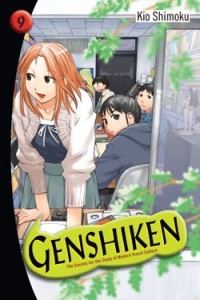
Vol. 9
(by Kio Shimoku, Del Rey, $10.95)
FROM THE BACK COVER:
"It's graduation day for Kanji, Kousaka, and Saki—and the whole Genshiken gang is there to cheer them on. Get Ready? for the biggest celebration of all time! Kanpai!
Final volume."
EVIDENCE FOR:
It's funny, that when I first started with Genshiken, I dismissed it by saying, "Well, I don't need to read a series about people who do things that I already do." But these characters have grown so endearing over the years, and with this final volume, there's only the bittersweet pain of having to let them go. This ending hits its stride in the middle with a trio of heartwarming chapters: Sasahara supporting Ogiue's manga aspirations in "Rain or Shine" (a must-read for any future artist), the eternally unresolved and unrequited love between Madarame and Kasukabe in "The Confession," and a wordless tribute to everything the Genshiken stands for in "Forever In My Dreams." And really, who needs words at all when Kio Shimoku has so completely mastered the art of gesture drawing? Every expression, every action, says something about the characters as they look back fondly on the years they've spent together as college pals. Add in the detailed background art and the clever references to just about anything, and it's the perfect portrayal of growing up geeky. (A brief visit from the club's gaijin friends also ups the comedy factor.) It's funny, it's sweet, it's heart-tugging, it's a complete slice-of-life experience. In a world where character popularity polls and fan-driven merchandising rule the day, Genshiken is one of the last few series made with Pure Love.
EVIDENCE AGAINST:
What is it about endings always falling short? The final chapter and the epilogue are a letdown compared to the dramatic sweep of the middle chapters; it's really just 30 pages of padding as the characters hang out post-graduation and finish up some club business. (Congrats, Ogiue...) Even the epilogue scene doesn't help much—instead of adding a sense of finality, all it does is add even more padding. Do we really need to hear about the theory of moe characters? In the middle stages of the series, maybe yes, but shoving that kind of conversation into the finale just doesn't sit right. In a way, it feels as if the last few chapters were all attempts at a "final chapter," except each one didn't quite work, so Shimoku had to keep going and make up more and more final chapters, until finally we get the anticlimax you see here. In fact, compared to the flow of the Sasahara/Ogiue arc in Volume 8, this is quite the disjointed finale, changing focus between characters and trying to tie up each subplot one at a time, rather than dealing with the club as a whole. So yes, it's over, but not quite as perfectly as one might have imagined.
FINAL VERDICT:
It may have dropped the ball in trying to pace the ending correctly, but the middle chapters are so touching, it still earns an A-.
NOISE
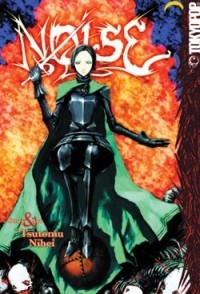
(by Tsutomi Nihei, Tokyopop, $9.99)
FROM THE BACK COVER:
"As detective Musubi Susono investigates a series of child kidnappings, her own partner is viciously murdered. But when the investigation takes a brutal turn, she is suddenly confronted by the killer—and his sadistic silicon creature...
From Tsutomu Nihei (Wolverine: Snikt!, the Halo graphic novel, and the sci-fi epic Blame!) comes a tale set in a future that is rife with decay and clamorous discord."
EVIDENCE FOR:
Ultra-futuristic dystopian settings come up all the time in the pop culture universe, but nobody does it like Tsutomu Nihei. Nobody! His sense of atmosphere makes Noise an unforgettable work, filled with towering structures, claustrophobic corners, and elegantly gruesome cyborg-beasts. It's as if Nihei never drew anything at all: no, he simply carved it out of his imagination, chipping away with a nib pen until the scratch-and-hatch visuals emerged fully formed. Were it not for Susono's human presence, we might be completely overwhelmed by everything this world has to offer; fortunately, her point of view allows us to experience things one at a time. Beginning with a simple murder case, it escalates all the way to an epic transformation where Susono becomes embedded in the "Netsphere" and must defend herself in a war of monsters and technology. Whether it's quiet introspection or blazing gunfights, every moment is a unique experience, and Nihei's storytelling is grand enough to match his wild artistic ideas. There's never been a vision of the future quite like this.
EVIDENCE AGAINST:
Um ... let's take a step back, shall we? There have been many visions of the future like this, and the only thing special about Noise is that it's drawn differently. Beneath the fancy scribblework lies a linear, monster-battling plot that tries to achieve an epic blockbuster feel but never quite gets there. If it had been a multi-volume series, Susono's quest would have been a more satisfying experience—but packaged like this, it feels like an abridged version that ends far too quickly. There's even enough leftover space to include the original one-shot of Blame!, which should tell you just how short it is. The storyline isn't the only thing that needs help: Susono's character is decidedly lacking in originality, as she just happens to borrow all the Strong Silent Badass-From-the-Future stereotypes. Even her climactic transformation takes a page out of the Ghost in the Shell playbook, guaranteeing that Tsutomu Nihei will never be seen as a true innovator, but merely a very talented imitator.
FINAL VERDICT:
Who says every sci-fi piece has to reinvent the genre? With rich visuals and a unique world, this one's good enough for a B.
SPIRAL: THE BONDS OF REASONING
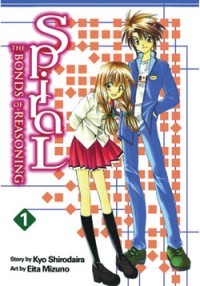
Vol. 1
(by Kyo Shirodaira and Eita Mizuno, Yen Press, $10.99)
FROM THE BACK COVER:
"'I'm going to uncover the mystery of the Blade Children.'
World-class detective Kiyotaka Narumi's last words prior to his sudden disappearance continue to haunt his younger brother, Ayumu. The cheeky 10th-grader becomes equally embroiled in the mystery of the doomed 'Blade Children' when he is mistaken for the prime suspect in a murder at his school. Led by Ayumu's sister-in-law, Kiyotaka's wife and fellow detective, Madoka, the investigation into the murder gives Ayumu a chance to clear his name. But in doing so, he not only uncovers ties to the Blade Children but also more questions than answers about who and what they are."
EVIDENCE FOR:
Spiral starts things off with a bang, or rather, a thud—what could be more shocking than seeing a schoolkid fall to her death off a building? From there it hits the ground running, seamlessly connecting each mystery to the next: the prime suspect suddenly gets murdered as well, and meanwhile it turns out that her motive was to cover up another murder of her own ... well, let's just say that "spiral" is the right word for it, because things keep spinning round and round into an ever tighter circle of conspiracy. On a chapter-by-chapter scale, it reads like most manga mysteries, where elaborate murders are solved through Ayumu's sharp deductive skills. Where it stands above the rest, however, is in the way each case is nested within a greater story arc, making it work on multiple levels. A visual flair for the dramatic also adds to the atmosphere—there are quite a few moments in the book where, as soon as you turn the page, it reveals another layer of conspiracy like you've never seen. This is a whodunit thriller at its best, featuring a mystery-within-a-mystery that's sure to keep would-be sleuths hooked. Can you figure it out before Ayumu does?
EVIDENCE AGAINST:
The plotting may be delightfully byzantine, but there's just something about the atmosphere of the story that makes it ... not mysterious enough. The main characters seem to be taking these student deaths very lightly, as if they're just cute little puzzles to be solved. Yes, people run around being shocked, and try to act traumatized about losing their friends, but it all feels very artificial; this volume jumps into the story so quickly that it doesn't have time to get us involved with the characters. Without any emotional or personal bond, well, we're just watching cartoon drawings get killed and solve mysteries. Speaking of cartoon drawings, the art style is laughably late-90's here, with Ayumu's ultra-spiky hair and other cookie-cutter character designs guaranteed to violate one's aesthetic sensibilities. It's not that the art is necessarily bad—it's just very ordinary, and clearly a product of its time. The backgrounds and buildings also lack any particular feeling or style; perhaps these shortcomings are also to blame for the lack of atmosphere. And what's with the last two chapters, which seem disconnected from the rest of the story at large? Let's focus on the Blade Children, folks—or at least on stories that relate back to them.
FINAL VERDICT:
A twisted and compelling plot, to be sure—but the lack of character depth, as well as a ho-hum visual style, knock this debut down to a B-.

DETROIT METAL CITY
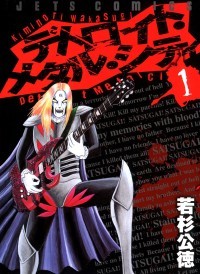
Vol. 1
(by Kiminori Wakasugi, Hakusensha, ¥505)
FROM THE BACK COVER:
"Souichi Negishi is a guy who likes sweet, stylish light-pop music. But somehow he's rocketing in popularity as 'Krauzer the 2nd,' the charismatic frontman of an indies death metal band! Tension is on the rise as this young talent begins to bloom..."
EVIDENCE FOR:
Just so we all know: "Detroit Metal City" is the name of the band, and yes, the whole manga is as ridiculous and parodical as the name suggests. Like many forms of broad comedy, it relies on a simple premise: in this case, the hilarious contrast between mild-mannered Souichi and his Satanic, singing-about-rape-and-murder alter ego. The send-up of death metal subculture is pretty funny in itself, but the piling-on of Souichi's weenie traits is where the humor really starts to Shine: his affection for his mother, his sensitivity towards women, his preference for sophisticated J-pop singer Kahimi Karie (listen to her stuff sometime and you'll get the joke; you might even find a new artist to like). It's just such a polar divide that anything "Krauzer the 2nd" does is instant comedy, simply because of the guy behind the make-up. Towards the end of the volume, things really get riotous as Souichi finds himself engaged in a battle of the bands against Ozzy Osbourne—I mean, "Jack Ille Dark"—and later has to rehabilitate his brother back home after realizing that he's accidentally created a DMC fan in the family. Sure, there are plenty of stories about following one's musical dreams, but there has never, ever been one as funny as this.
EVIDENCE AGAINST:
Like many other comedies based on a simple idea, this series runs the danger of getting really repetitive really quickly. Many of the middle chapters (which are already pretty short) rely on the same situational humor over and over: Souichi is trying to be his normal, weenie self, but then the metal alter ego kicks in. This formula becomes particularly obvious when he's trying to impress a woman, which happens at least three times in this installment, and sometimes even repeats with the same character. Recycling plotlines when you're not even out of Volume 1? That's never a good sign. And just like other comedies of its kind, this one's not going to win any awards for the art. Stiff poses, forgettable character designs, cardboard facial expressions—it's a good thing this one's got the humor going for it, because it's not that great to look at (except for Souichi's outrageous costume and make-up job when he turns into Krauzer). When it comes to rock-show details and demonic imagery, the visuals come out a little better, but this one is clearly about the amusing substance rather than the style.
FINAL VERDICT:
If nothing else, this is a guaranteed laugh from start to finish. And hell, Krauzer could probably strangle the entire cast of Beck with one hand, so nobody's allowed to say anything mean about him.
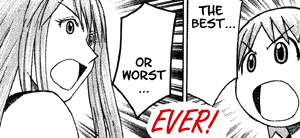
There comes a time, in every manga reviewer's life, when they realize that they have come upon something so beautiful, so magnificent, that reviewing individual volumes cannot do it justice. That's why this week's Best Manga I've Ever Read is the one right up there in the banner:
YOTSUBA&!

(by Kiyohiko Azuma, ADV Manga, $9.99 ea.)
To understand what makes Yotsuba&! both a fan favorite and critical darling, just think about what it accomplishes. It's cute and makes people laugh, and it does it without making you feel like an idiot. Such is the way of Kiyohiko Azuma's slice-of-life storytelling, which was mastered within the four-panel pillars of Azumanga Daioh but perfected only in the full-chapter format that Yotsuba&! brings. In theory, it shouldn't even work—aren't most series about six-year-old kids supposed to be brainless grade-school filler or creepy pedo parades? But Yotsuba Koiwai's adventures are neither—instead, it's a lucid and charming look at the world through a child's eyes, as she gets into scrapes that remind us all of our own childhoods (if only through manga-tinted glasses).
Because of the short chapters and sketch-comedy approach, it's hard to pin down one overall shining moment in Yotsuba&!. Rather, the series comes together as the lump sum of lots of adorable little moments, like when Yotsuba gets a water pistol and decides to go around "killing" everyone around the house, or she becomes a "reporter" and accidentally broadcasts one of the neighbor girls' love problems to the entire household, or tries to fight global warming by turning on all the air-conditioning. Not only that, but her supporting cast is endearing as well: everyone's got a soft spot for big uncle Jumbo, whose long-suffering crush on attractive neighbor Asagi may never be resolved, and even Yotsuba's imaginary friends and foes (the giant eyeball; the cardboard robot) delight us with their imaginative flair. Drawn in a simple style—but not as elementary as Azumanga—with idyllic scenes of suburban life, this is one title that's both great to read and great to look at.
My only complaint? You never can tell when ADV Manga will be on time with the next translated volume. But perhaps that's what makes me treasure Yotsuba&! all the more.
discuss this in the forum (25 posts) |